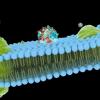
C60 in olive oil mediated life extension: Scientific discussions
#301
Posted 15 July 2012 - 10:41 AM
#302
Posted 15 July 2012 - 11:31 AM
I think they could take various human tissue lines at 1, 3 , 7 ,10 hayflick divisions remaining then see if buckminsterfullerene notably ncreased the longevity pf the human tissue types. They could publish meaningful human data at less than 2 months of observing the near limit cytes living longer.
There is even the possibility of transplanting 1, 3, 7, 10 hayflick division remaining cytes to a living animal, then feeding it oil, oil with buckminsterfullerene, as well as regular food to see if metabolites or body responsive cytokines were actually causing the effect
This is equivalent to giving C60 to old animals--for instance, a C60 experiment could be piggybacked on the rats of some other finished experiment.
It's unlikely that "Hayflick divisions remaining" could ever be identified with any precision, but it doesn't matter because the action of C60 seems to be on the mitochondria, which isn't limited in this way. The mtDNA has a bacterial-style loop with no telomeres, and can undergo thousands of divisions.
#303
Posted 15 July 2012 - 11:53 AM
The errors are massive, in my opinion. How could anyone look at a graph showing the final animal dying at 66 months and miss that it was off by nearly ten months? And how could they put down two animals and fail to mention it? People who are this sloppy can be sloppy in other ways. For instance, an experiment that goes on years could be ruined if some student forgot to feed the animals and then covered it up by replacing them. Such things can happen, but from my personal experiment with C60, I doubt there was any such funny business. It would be too much of a coincidence that C60 just happened to have such dramatic real effects for me--hair regrowth and enhanced oxygen utilization--while the experiment with rats had equally dramatic fake effects.
Edited by Turnbuckle, 15 July 2012 - 12:36 PM.
#304
Posted 15 July 2012 - 05:31 PM
Actually, according to Baati, in a communication made subsequent to publication, this did occur - the two longestOr one of the student lab assistants accidently killed some rats
lived fullerene dosed rats were accidentally killed during handling. At this point they were very frail....but if they had not been killed, they would have hung in there for who knows how much longer? A week? Another month? This was not reported in the study - there was no need to report it, as their lifespan was already greater than all the other rats.
#305
Posted 15 July 2012 - 05:35 PM
Turnbuckle - there were no errors in the printed text.The errors are massive, in my opinion.
The graph error was an artefact of a computer programe, that moved the data points forward. This kind of thing can stare you in the face, and you don't see it. The error with the slide substitution was non-significant. The researchers didn't spot it. The reviewers didn't spot it. Most of the people looking at the paper didn't spot it, for a while.
However,the raw data that generated the graph is not under dispute.
The review committee held that the publication stood, after a request for additional supporting evidence. The findings were not materially affected by the graph or the slide.
#306
Posted 15 July 2012 - 05:49 PM
Actually, according to Baati, in a communication made subsequent to publication, this did occur - the two longestOr one of the student lab assistants accidently killed some rats
lived fullerene dosed rats were accidentally killed during handling. At this point they were very frail....but if they had not been killed, they would have hung in there for who knows how much longer? A week? Another month? This was not reported in the study - there was no need to report it, as their lifespan was already greater than all the other rats.
Equally odd are the last two rats in the OO group that lived considerably longer than the others, only to die in the same month. But with small populations like these, oddities should be expected.
#307
Posted 15 July 2012 - 05:56 PM
No, it contained two errors, not several.The published paper contained several errors.
This is written emotively to make it sound as though there is no justification. it isn't a 'claim', It is an observation based on the reported evidence.Even after the correction, the authors still claim a dramatic effect on lifespan.
There is no revised data. The statistical analyses were not performed on the data generated by the graphing software, but by the original data.While in the revised data C60 essentially adds to the dramatic lifespan effects of olive oil.
17 months longer than the longest lived control in this study, where n=6The mean lifespan of the olive oil and the water fed animals was quite similar but the maximal lifespan was increased by an astonishing 17 months.
More meaningful is to compare it to the maximal observed lifespan of Wistar rats.(1400 days for females, 1200 for males - i.e. around 200 weeks, or 50 months ( at 4 weeks per month) (UFAW handbook)
In other words, no, or not much, lifespan extension above the theoretical maximum for the olive oil alone dosed rats.
Edited by Metrodorus, 15 July 2012 - 05:59 PM.
#308
Posted 15 July 2012 - 07:33 PM
Hi Metrodorus,Actually, according to Baati, in a communication made subsequent to publication, this did occur - the two longestOr one of the student lab assistants accidently killed some rats
lived fullerene dosed rats were accidentally killed during handling. At this point they were very frail....but if they had not been killed, they would have hung in there for who knows how much longer? A week? Another month? This was not reported in the study - there was no need to report it, as their lifespan was already greater than all the other rats.
I prefer to be extremely transparent because the goal is to be right to the point; and for that to be able to revise what has been badly formulated if needed.
1. What is your source? Personal communication with you, other? This was a point where I was not 100% sure and I was going to ask more precision to the other authors. The personal communication that I had (or remember, of course) was that they were effectively killed, but not by "accident": rather because the poor rats were old and that it sounded inadequate for the husbandry to make they suffer longer. However it is not necessarily very different I haven't asked much details about it because I had too many others questions at the same time and it was quite late.
2. Concerning the critique of the critique, indeed there was a big change of style following the intervention of a LongeCIty reviewer. It was decided to publish this critique but to modify it later if needed; I did not categorically refuse due to lack of time (and not only style changes to defend, eg http://www.longecity...val-statistics/ ) but I imagine that with s123 we will adapt the style. Of note: I do not want to only blame the reviewer as otherwise he did a very good job. I think things were just done with lack of time, and now it is the phase to readjust things.
#309
Posted 15 July 2012 - 08:30 PM
If the rats were euthanised, then the text quoted from the critique is misleading, as it lead me directly to a conclusion of accidental death through a handling error.The corresponding author orally stated in personal communication that the last two rats were killed while not being in very good shape, due to procedures of the animal husbandry; therefore they may have lived a little longer,
To avoid ambiguity, you would need to say " The rats were deliberately killed because they were in poor health", or, preferably, "The rats were euthanised at X months, in accord with animal welfare guidelines, as they were in poor health". ( I assume some such guidelines would have been the reason why they were put down).
#310
Posted 15 July 2012 - 09:00 PM
#311
Posted 15 July 2012 - 09:12 PM
Well, the GAop/GAip image, the survival graph, the "M38" in the text and possibly the reported control EML of 22 months. I guess it is a question of degree or understanding (the last two are the type of errors that we sometimes find even in the most revised papers; the last one could be some lack of clarity only). For the rest I globally agree.No, it contained two errors, not several.The published paper contained several errors.
Edited by AgeVivo, 15 July 2012 - 09:21 PM.
#312
Posted 15 July 2012 - 09:32 PM
oh I get it. euthanised indeed.
It's possible they were anxious to be done with the experiment and get the paper out, but these dang C60 rats refused to die.
#313
Posted 17 July 2012 - 12:03 AM
If we were to rely on medical studies rather than the anecdotal accounts "lab rat" self-experimenters, and lunatic fringe body hackers, we'll all be dead before anything "conclusive" is published on C60/OO.
Meanwhile, I have to say, my hair is indeed looking "Stalin-Esque."
#314
Posted 23 July 2012 - 01:38 AM
If I understand things correctly anti-oxidants like vit C etc. are extra cellular.
They dont get into the cells and mitocondria to kill ROS there right?
So perhaps C60 acts as a ... 'conductor' in the cell walls; soaking up intra-celular ROS and passing the + charge on to extra-cellular anti-oxidants.
It just never made sense to me that C60 could soak up + charged ROS ie: neutralise + charged molecules by donating an electron unless it gets electrons from somewhere.
Perhaps its conducting negative charges from extra-cellular anti-oxidants through cell walls into cells and mitochondria?
Perhaps extra-cellular anti-oxidant levels have to be optimal or higher for C60 to be effective.
Are those seeing the most benifits also taking largish doses of normal anti-oxidants?
#315
Posted 23 July 2012 - 03:10 AM
I have a wild theory:
If I understand things correctly anti-oxidants like vit C etc. are extra cellular.
They dont get into the cells and mitocondria to kill ROS there right?
So perhaps C60 acts as a ... 'conductor' in the cell walls; soaking up intra-celular ROS and passing the + charge on to extra-cellular anti-oxidants.
It just never made sense to me that C60 could soak up + charged ROS ie: neutralise + charged molecules by donating an electron unless it gets electrons from somewhere.
Perhaps its conducting negative charges from extra-cellular anti-oxidants through cell walls into cells and mitochondria?
Perhaps extra-cellular anti-oxidant levels have to be optimal or higher for C60 to be effective.
Are those seeing the most benifits also taking largish doses of normal anti-oxidants?
Well, you have the general idea right. Typical antioxidants do get into the cell, however. If they are hydrophilic, like vit C, they'll mostly be in the cytosol, and if they are hydrophobic, like vit E, then they'll be mostly in the membranes. ROS aren't positive; they're either negative, as in superoxide anion, or they are neutral, as in the hydroxyl or peroxyl radicals. What C60 does exceedingly well is accept an electron from something like superoxide, 'O2-, where the single quote indicates an unpaired electron. The reaction is:
C60 + 'O2- ---> C60- + O2
Now the C60 has an electron that it needs to hand off to something. C60 can delocalize the extra electron in such a way that it is stable, so it won't attack a biological molecule. Instead, it waits until something comes along that can accept the electron. It could even be another superoxide anion, which by adding an electron and two protons can form hydrogen peroxide, a relatively stable molecule, at least compared to superoxide.
The C60 will be found mainly in the hydrophobic part of the membranes, but there is not a strong cutoff between the aqueous portion of the cell and the hydrophobic tails of the lipids in the membrane. Instead, there is a little bit of mixing, so the C60 will, as you hypothesized, get a chance to hand off an electron to an electron acceptor in the water.
#316
Posted 23 July 2012 - 08:21 AM
That would be the reason that they mixed it in darkness.
So, I'd wouldn't take a mixture that was done with any light exposure, just in case you are thinking of ingesting it.
It took two weeks of stirring to get the C60 dissolved in the olive oil, so the adventurous among us should probably ask Santa for a good magnetic stirrer.
I tried C60 twenty years ago for an industrial application and I saw how difficult it was to dissolve in most solvents, so I was a bit surprised it went into vegetable oil so easily for these researchers. Anyway, I ordered another sample and yesterday added 400 mg to 500 ml of extra virgin olive oil, and within two or three hours, the light green of the oil had begun to darken. After the occasional hand shaking and 20 hours, about 95% dissolved (just eyeballing) and it's now a greenish whiskey color, about what you'd expect if you added the magenta color of a C60-toluene solution to the light green of the olive oil.
Edited by mikey, 23 July 2012 - 08:22 AM.
#317
Posted 23 July 2012 - 11:17 AM
Well, you have the general idea right. Typical antioxidants do get into the cell, however. If they are hydrophilic, like vit C, they'll mostly be in the cytosol, and if they are hydrophobic, like vit E, then they'll be mostly in the membranes. ROS aren't positive; they're either negative, as in superoxide anion, or they are neutral, as in the hydroxyl or peroxyl radicals. What C60 does exceedingly well is accept an electron from something like superoxide, 'O2-, where the single quote indicates an unpaired electron. The reaction is:
C60 + 'O2- ---> C60- + O2
Now the C60 has an electron that it needs to hand off to something. C60 can delocalize the extra electron in such a way that it is stable, so it won't attack a biological molecule. Instead, it waits until something comes along that can accept the electron. It could even be another superoxide anion, which by adding an electron and two protons can form hydrogen peroxide, a relatively stable molecule, at least compared to superoxide.
The C60 will be found mainly in the hydrophobic part of the membranes, but there is not a strong cutoff between the aqueous portion of the cell and the hydrophobic tails of the lipids in the membrane. Instead, there is a little bit of mixing, so the C60 will, as you hypothesized, get a chance to hand off an electron to an electron acceptor in the water.
Thx Niner (for this and in the past)
I always thought ROS are + and steal electrons from our cells.
I suppose this was based on my understanding that Oxygen is very electronegative.
More study obviously reqd!
Edited by Logic, 23 July 2012 - 11:18 AM.
#318
Posted 28 July 2012 - 10:47 PM
Edited by Allen Walters, 28 July 2012 - 10:48 PM.
#319
Posted 28 July 2012 - 10:59 PM
Hi Allen,I had some major weight lifting gains, and then had swelling in my elbow that caused ulnar nerve compression.
My dosing regime is similar to yours.
I ended up with the same problem as you - tendonitis primarily, and possibly some nerve compression due to swelling. I didn't take meds, apart from a little ibuprofin and ice packs. I just stayed out of the gym for four weeks. In my case, it was brought on by very high reps ( 60 - 100 reps) of quite heavy masses.
I went back to the gym yesterday - and eased back into my regime. High masses - low reps (10 reps per set). I don't want to risk another repetitive strain injury.
I went again today. The affected tendon is part of the the elbow attachment of the triceps, so I will be very light on triceps until the tendonitis goes away. I no longer have elbow pain.
I am going to stick to high weights/low reps, and build back up to where I was before, and this time be careful to not keep going, even though my muscle strength would allow me to.
I have not had more detailed dreams, but something analogous: when I close my eyes and I am about to drop off, something new happens - I get really vivid real-time visions. I am still wide awake. I cannot control them - I have tried to order myself to visualise various scenes - but I do not have control - it is just like a little movie collection my brain is showing me - usually faces, sometimes it is more entertaining. Then I drop off to sleep. This never happened before I took C60, and I quite like it. It is harmless, I expect.
Edited by Metrodorus, 28 July 2012 - 11:00 PM.
#320
Posted 28 July 2012 - 11:17 PM
#321
Posted 28 July 2012 - 11:20 PM
#322
Posted 29 July 2012 - 12:59 PM
I started taking prednisone for the swelling. Sense then I've noticed feeling much better all around, especially after taking my c60. I wonder if my immune system being compromised by the medication is allowing the c60 to get around it? I have been having very detailed dreams, and I feel more focused. I wonder if wistar rats have bad immune systems, and allows the c60 to work on them? Or maybe I have an auto immune issue that's not been diagnosed.
The feeling better all around, and maybe some of the dreaming is probably just the prednisone doing its thing. It is a very potent steroid with a lot of side effects. It can induce a hypomania in me, which I quite like, actually.
The overuse injury scenario that Metrodorus mentioned sounds pretty plausible- Do you think that's what happened to you? i.e., did you start lifting heavier and/or a lot more reps?
My dreams have been very detailed, tactile and in color. Like last night I had a dream that I was with a girl and I touched her arm and noticed how smooth and cool her skin felt. I've never had dreams like this.
I wonder what she'd do if you increased the dose?
#323
Posted 29 July 2012 - 06:25 PM
That's exactly what I did. I was adding weight every time I worked out and my elbow couldn't take it.The overuse injury scenario that Metrodorus mentioned sounds pretty plausible- Do you think that's what happened to you? i.e., did you start lifting heavier and/or a lot more reps?
#324
Posted 20 August 2012 - 03:43 AM
I agree that the study group is smallish but there's several interesting bits to be found in the full text (http://extremelongev...0-Fullerene.pdf) that are suggestive of interesting (possibly novel?) life extension properties of C60.
Here's what stood out for me when I read the study, let me know if I'm blatantly off on any of the points,
- It is interesting that the C60 is almost equally well absorbed orally as compared to IP injection (body cavity injection)
- C60 crosses the BBB - "the presence of significant amounts in the brain 24 hours after both oral and i.p. administrations under our experimental conditions (Table 2) confirms that solubilized C60 can cross the bloodebrain barrier"
- It might well be that compounds formed when C60 breaks down are instrumental to the health benefits, it is as of yet unknown how the animals process/eliminate the C60 - "we have to look for other possible biotransformations and elimination routes, all the more so as the fate of the addition product is not known."
- The C60 seems to work by down-regulating the amount of anti-oxidant activity in the rats (both Catalase and SOD); especially when under stress from CCl4 (Carbon tetrachloride?). Yet, it still obviously manages to protect them very well.
Number 4 - I was involved in supplying the US National Weight Lifting Team with vitamin C in an internal study looking at how vitamin C affected cortisol. 1,000 mg of vitamin C reduced cortisol production by ~20%. It was concluded that vitamin C's antioxidant/anti-inflammatory effect rendered less need to produce cortisol, which is also an antioxidant. Thus, cortisol production by the body was decreased because the feedback loop that controls cortisol sensed less need for cortisol's antioxidant/anti-inflammatory effect.
Because of this experience I interpret the down-regulation of SOD, catalase and glutathione in the study as C60 causing less need for them to detox carbon tetrachloride (CCI4) because C60 did the job so well.
#325
Posted 20 August 2012 - 03:52 AM
I have a wild theory:
If I understand things correctly anti-oxidants like vit C etc. are extra cellular.
They dont get into the cells and mitocondria to kill ROS there right?
So perhaps C60 acts as a ... 'conductor' in the cell walls; soaking up intra-celular ROS and passing the + charge on to extra-cellular anti-oxidants.
It just never made sense to me that C60 could soak up + charged ROS ie: neutralise + charged molecules by donating an electron unless it gets electrons from somewhere.
Perhaps its conducting negative charges from extra-cellular anti-oxidants through cell walls into cells and mitochondria?
Perhaps extra-cellular anti-oxidant levels have to be optimal or higher for C60 to be effective.
Are those seeing the most benifits also taking largish doses of normal anti-oxidants?
It depends on which form of ascorbate (vitamin C). Ascorbyl palmitate goes intracellular. And IV ascorbic acid is said to deliver about 20% intracellular.
Oncol Res. 1999 ;11 (10):479-87 10850889 Cit:14
Antimetastatic and anti-invasive ability of phospho-ascorbyl palmitate through intracellular ascorbate enrichment and the resultant antioxidant action.
J W Liu, N Nagao, K Kageyama, N Miwa
Department of Cell Biochemistry, Hiroshima Prefectural University School of BioSciences, Shobara, Japan.
A lipophilic and auto-oxidation-resistant derivative of ascorbic acid (Asc), Asc-2-O-phosphate-6-O-palmitate (Asc2P6Plm), was shown to exert an invasion-inhibitory action as promptly as 30-40 min for 50% inhibition and 60-90 min for 80% inhibition after entering fibrosarcoma HT-1080 cells. Invasive inhibition of 95-97% was accomplished by Asc2P6Plm of doses exhibiting no cytotoxicity under the same conditions. Asc2P6Plm was dephosphorylated and esterolyzed to Asc, which enriched the intracellular Asc dose dependently in invasion-suppressed cells, contrasting with no detectable Asc in invasive cells fed without Asc2P6Plm. Intracellular dehydroAsc (DehAsc), unexpectedly, amounted to 1.02-1.65-fold as much as intracellular Asc, suggesting that invasive cells underwent oxidative stress, the repression of which resulted in both inhibition of tumor invasion and oxidative conversion of Asc to DehAsc. Correspondingly, intracellular oxidants fluorometrically detected with a redox indicator CDCFH were more abundant in invasive cells than in invasion-suppressed cells fed with Asc2P6Plm. Invasion inhibitory effects of Asc2P6Plm necessitated the extensive inhibition of the major gelatinases MMP-9 and MMP-2, as shown by zymography and Western blots, but did not necessitate direct expression of the metastasis suppressor gene nm23, taking as long as 6-18 h in contrast to a prompt action of Asc2P6Plm. Antimetastatic effects on melanoma B16BL6 cells were given dose dependently by intravenous administration or pretreatment with Asc2P6Plm. Thus, Asc2P6Plm is anticipated as an antimetastatic agent via the potent antioxidant activity.
Keywords: asc; antimetastatic; mmp; intracellular ascorbate; ascorbate; palmitate; anti-invasive; antioxidant; intracellular; cell; invasive cell; antioxidant action; through intracellular; invasive; cell fed;
#326
Posted 20 August 2012 - 04:01 AM
Hi Allen,I had some major weight lifting gains, and then had swelling in my elbow that caused ulnar nerve compression.
My dosing regime is similar to yours.
I ended up with the same problem as you - tendonitis primarily, and possibly some nerve compression due to swelling. I didn't take meds, apart from a little ibuprofin and ice packs. I just stayed out of the gym for four weeks. In my case, it was brought on by very high reps ( 60 - 100 reps) of quite heavy masses.
I went back to the gym yesterday - and eased back into my regime. High masses - low reps (10 reps per set). I don't want to risk another repetitive strain injury.
I went again today. The affected tendon is part of the the elbow attachment of the triceps, so I will be very light on triceps until the tendonitis goes away. I no longer have elbow pain.
I am going to stick to high weights/low reps, and build back up to where I was before, and this time be careful to not keep going, even though my muscle strength would allow me to.
You might try DMSO (transdermal) gel on any soft tissue inflammation or swelling. It donates methyl groups, sulfur and oxygen to radically decrease inflammation and swelling and ramp up healing/growth factor generation. I use the 90% gel from DMSO.com for acute problems and the 70% DMSO/30% Aloe from DMSO.net (#16) for more moderate injuries. The 90% is more drying on skin but works faster.
#327
Posted 23 August 2012 - 05:59 PM
c60 DMSO study. http://144.206.159.1...25/12825719.pdf
#328
Posted 23 August 2012 - 10:19 PM
I would just mix in as much as I could get to dissolve in DMSO, and please tell us how much that is after you have done it.I looked into and purchased some dmso, I hope it works. When I was searching google I found a pdf on hair growth with fullerenes, and they used dmso for the solvent, and applied it topically without NEEDLING!!!! Does anyone have any ideas on ratios? I'm gonna mix some up and try it.
c60 DMSO study. http://144.206.159.1...25/12825719.pdf
#329
Posted 24 August 2012 - 01:55 AM
#330
Posted 24 August 2012 - 02:21 AM
I looked into and purchased some dmso, I hope it works. When I was searching google I found a pdf on hair growth with fullerenes, and they used dmso for the solvent, and applied it topically without NEEDLING!!!! Does anyone have any ideas on ratios? I'm gonna mix some up and try it.
c60 DMSO study. http://144.206.159.1...25/12825719.pdf
Notice that these were fullerene derivatives in DMSO, not plain C60. However, I can attest that plain fullerene in EVOO does grow hair.
Also tagged with one or more of these keywords: c60, buckyballs, lifespan, baati, moussa, fullerenes
2 user(s) are reading this topic
0 members, 2 guests, 0 anonymous users






























 This topic is locked
This topic is locked


























